Sprouting and growing grain for livestock fodder is a simple and efficient way to not only feed your animals a more natural and fresh diet, but is also a practically effortless way to save money. Imagine for a second that the 50 lb. bag of feed you just bought could grow into 300 lbs. of feed that is more nutrient dense in just nine days. Huh wha?! Isn’t just the mere idea of cutting your feed bill worth the try? I think you will be pleasantly surprised.
Our farm has been feeding a flock of laying hen chickens quail, and angora (wool producing) rabbits a 90% sprouted barley fodder diet for over a year now with wonderful results. The egg yolks are richer, the rabbits are healthier and even produce softer wool. We have fewer runts and losses when babies are born. We have incredibly cut our feed costs by 75% just by switching to sprouted fodder.
Sprouting fodder for livestock is similar to sprouting seeds for human consumption, but in an extreme degree. Think more along the lines of sprouting wheatgrass than the little bean sprouts you would put on a sandwich. By sprouting grain and harvesting it (feeding it to your animals) right before the sprouts get their second leaves at about 7-10 days, you do not need to use anything more than water to grow them –not even fertilizer. The action of sprouting amplifies the natural proteins, vitamins, mineral, enzymatic activity, omega 3’s, amino acids, natural hormones, and stimulates immune response. Of course the increase in these wonderful benefits varies grain to grain.
The sprouted fodder, no matter what seed or grain you choose to use, is fed whole; greens, seeds, and sprouts as a whole. Commonly used grains for fodder are barley, wheat, and whole oats. Barley, which is the easiest to grow, has a crude protein percentage of 12.7 percent and a crude fiber percentage of 5.4 percent as a seed. These percentages jump to a crude protein percentage of 15.5 percent and a crude fiber percentage of 14.1 percent after an average of seven days of sprouting. By sprouting, the digestibility of the grain increases from 40 percent to 80 percent so livestock will not need to consume as much fodder compared to commercial feed because they are obtaining more nutrition from a smaller volume of feed.*
As far as setting up your own fodder sprouting system, there are many options out there for purchase. The only problem you will run into is that there are no fodder sprouting systems for smaller operations, like say, a homestead where you only have one horse, or a few goats, or a small herd of rabbits, or a modestly sized flock of chickens. For us, you will be left to build your own. But no worries folks! A system can easily be set up using materials you already have laying around or using items from the local discount or dollar store. You’re in good hands here DIY’ers.
Before we start, you will need to figure out how much finished fodder your animals will be eating on a daily basis. I have included a rough estimate for the more common homestead animals, but please do your own research on feed amounts and if necessary, consult your veterinarian. As any responsible animal or livestock caretaker, you will not only need to transition your animals onto fresh fodder, you will need to monitor their growth and maintenance rates to keep them in a healthy condition while you get used to feeding fodder. One month is a good amount of time to transition your animals to fodder. Ruminants especially need a few weeks to adjust their gut flora and rumen to new feed. Some animals will also require roughage or mineral supplements. Please only use these amounts as a guide.
• Horse: 2-3 percent of their body weight in fodder; 1.5% body weight in dry hay
• Beef Cow: 2-3 percent of their body weight in fodder; barley straw ration
• Dairy Cow: 3-5 percent of their body weight in fodder; barley straw ration
• Sheep: 2-3 percent of their body weight in fodder; hay ration
• Goat: 2-3 percent of their body weight in fodder; mineral and hay rations
• Dairy Goat: 3-5 percent of their body weight in fodder; mineral and hay rations
• Alpaca: 2-3 percent of their body weight in fodder; hay ration
• Pig: 2-3 percent of their body weight in fodder
• Rabbit: 3-5 percent of their body weight in fodder; hay ration for roughage
• Chicken: 2-3 percent of their body weight in fodder; grit and calcium supplements
To get started in growing your own sprouted fodder, you will need:
• 2” deep trays (look for inexpensive baking pans or dish pans at your local dollar store) with a moderate amount of small holes drilled in the bottom.
• bulk bag of untreated, feed grade, whole grain seed; barley, wheat, or oats (oats are the more difficult of the three common grain seeds to sprout and is more prone to mold)
• large bucket
• rack or shelf to keep your trays of seed on
Optional: water pump and hose to re-circulate the water used. Should you choose to recirculate the used water, I would recommend adding a quality water filter.
For the best growing results, I recommend that the temperature of your fodder system stays between 63 degrees F and 75 degrees F. The fodder can be grown with only ambient light, so although grow lights or direct sunlight can and will benefit your fodder, direct light is not necessary.
Mold is the most common problem reported in growing sprouted grains. To prevent mold:
• Be sure to rinse your grain very well before soaking. Your soaking water should be clean and clear of any dirt, debris, or empty husks.
• Add a 1% vinegar solution to the soak water. As a general measurement, you may use 1-2 teaspoons per gallon of water. The solution is just enough vinegar to kill most mold spores, but not the grain itself.
• Be sure to provide adequate air circulation
• Keep the sprouting fodder between 63 and 75 degrees Fahrenheit. Any cooler or warmer may result in pests, mold, and stunted growth.
• Clean all of your supplies and trays very well with vinegar or bleach.
When setting up a rack to put your sprouted fodder trays on, keep in mind that the rack will likely become wet during watering. A simple metal “storage” rack would be wonderful to use especially if a plastic tub of some sort can be placed underneath to catch any water poured through the system. Arrange the fodder trays so that the level below is lined up to catch any water from the tray above. Another good idea would be to drill holes in one side of each tray and then raise the un-draining side by about 1-2 inches. Alternate which side is raised on each consecutive level so that the first tray drains into the second tray, the second tray drains into the third, and so on. You can pour water from a bucket into the first trays or you could set up a small fountain pump on a timer with a hose leading to the top trays to water all of your fodder. Good air circulation is key to keeping mold from growing in your fodder so choose a location for your system that receives plenty of fresh air.
Here is an easy system to follow:
(Remember: in order to keep your sprouted fodder growing in a cycle for fresh fodder every day, be sure to start a new batch of seeds every day. )
Step 1: Soak the needed amount of dry seed/grain in a large bucket. Fill the bucket with cool water at least two inches above the seeds. Allow the seeds to soak for 12-24 hours or even overnight. A shorter soak time may result in less seeds germinated.
Step 2: After the seeds have soaked, drain the water and dump the seeds into the appropriate amount of trays. The seeds should never exceed 1/2 inch deep otherwise mold may develop due to poor air circulation.
Step 3: Rinse or water each tray 2-3 times daily. The goal is to provide water for growth, but not allow standing water in the trays. Be sure after watering that each tray has drained well.
Repeat Step 3 for seven to nine days depending on the growth. Ideally, you will have about six inches of growth by day nine. Growth is very dependant on temperature and water.
Step 4: Harvest! Flip your tray over or pull the fodder from the tray and feel confident that you are feeding your animals a more natural feed! Feed the sprouted fodder whole; greens, seeds, and root mat. Because how densely the root mat that develops over the nine days, the fodder can be cut into serving portions with a box-cutter or knife much like a roll of housing carpet.
It really is that simple to grow sprouted fodder for your livestock. Just soak, drain, water and harvest! The most complicated element of this system will be sourcing grain or seeds to use. Of course if you have a local farm supply store, feed supply store, or local grain mill, it will be the most likely place to find seeds to use. Alternatively, seeds or grain in bulk can be found from online resources like Azure Standard, Tractor Supply Company, and state grain mills. A simple google search will probably find just what you need.
* Source: Cuddeford (1989), based on data obtained by Peer and Leeson (1985).

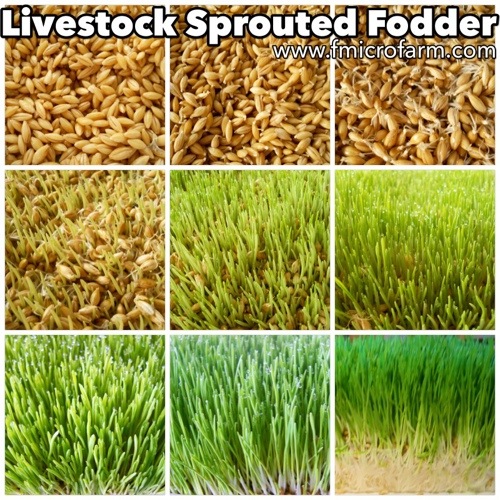
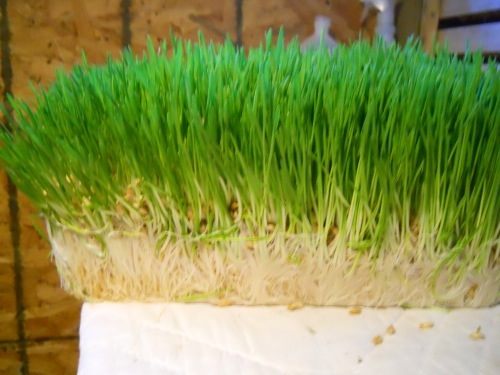
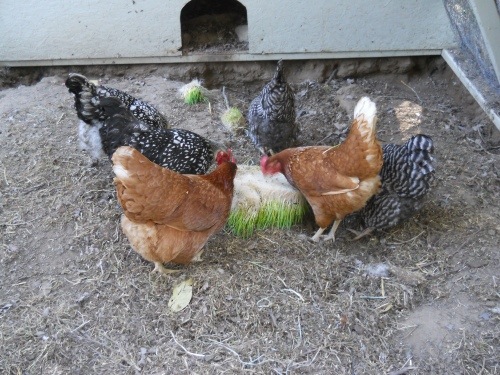
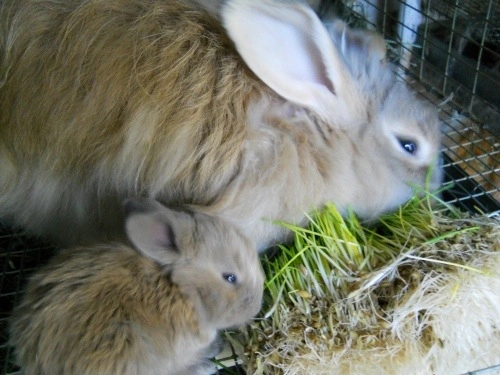
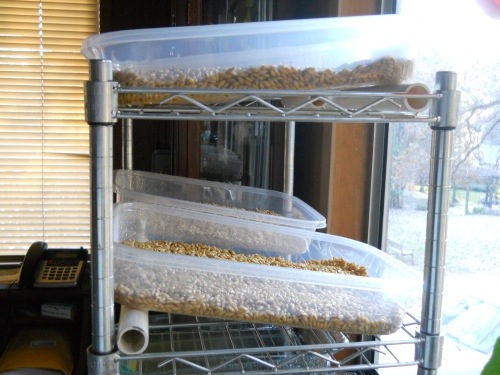
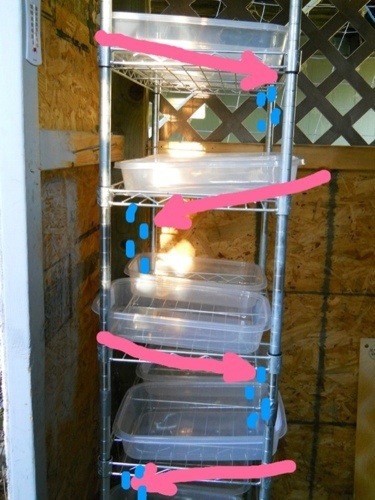
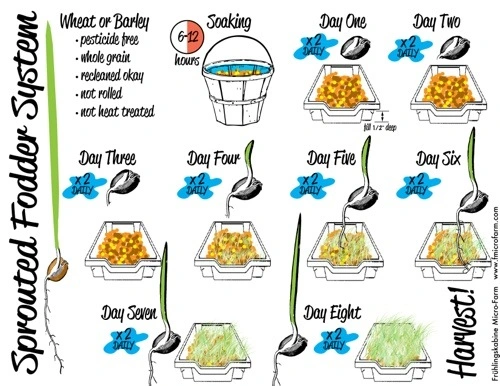
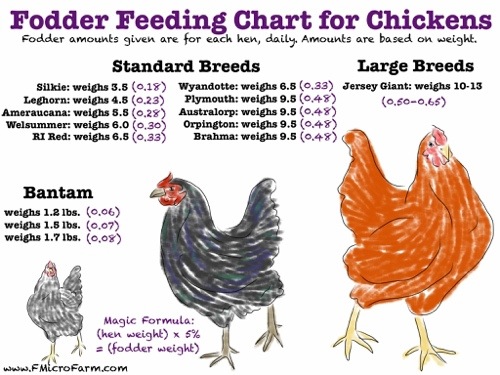
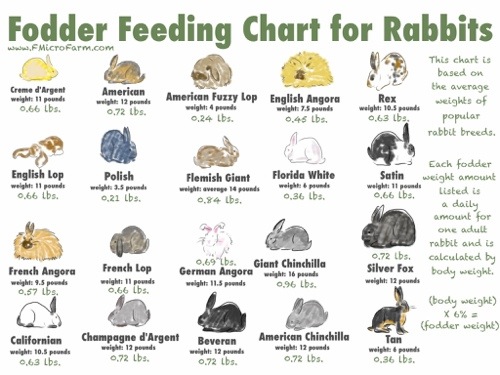
Loving the new updates on your blog!
Well, thanka!
My bunnies and guinnea pigs still enjoy their daily barley fodder!
And I’ve been liking my indoor ‘wintergreenery’ 🙂
Thanks Sarah!x!
Glad to hear it!
Reblogged this on homesteaddad and commented:
The most thorough description of how to feed fodder I have yet found. Even info on how much to feed animal types.
Thanks for spreading the word!
My rabbits (yes my outdoor one too now) and my Guinea pig absolutely love their wheat fodder. Now to transition the hens. Thanks Sarah. Oh BTW the 5 lb Angora I emailed you about has doubled in overall size and weight on the fodder. Buddy is now 10 lbs and a proper French/English mix size.
Wow! That is great progress!
There are a couple of places that sell small scale fodder systems now for the not so do it yourself inclined.
http://www.half-pinthomestead.com/FodderKits.html
http://www.hostilehare.com/products-page/fodder-kits/#.Uy51r_ldWSo
My husband has designed and will soon be building me a PVC fodder rack that we hope to eventually hook up to a pump and timer, but for now I am happy watering my fodder by hand.
Anyway, thanks for the in depth article. I can come back to it when we start raising goats, sheep, or pigs. How much did you feed your quail?
Yes, there are people who sell fodder systems, but considering that all you need is trays with holes in them and a rack… Spending $100+ can be unreasonable.
I fed 12 quail 1.5 cups of four day sprouted grain and about .5 pounds of eight day fodder each day. Some days they would eat it all and some days there would be some leftover.
Thank you for this concise, one stop, all you need to know, post. We have not started feeding fodder yet, we only have the hens for now but plan for rabbits soon. I am bookmarking this post to help guide us. Love reading your blog!
Thanks for reading and enjoy!
Hello again Sarah,
I have really been enjoying your posts and am so thankful for all of the fodder information that you have supplied! I hope all is going well as you establish your new (big!) homestead. We just bought 2 acres in Magalia, Ca. and are starting our homestead too. Living here I thought that maybe there would be a easy source for organic barley to sprout but it seems not! I’ve seen you mention Tractor Supply and I tried them but they said nay. Azure has some but I was wondering where you are getting yours since we are both in Ca. I would love to hear from you and I have been looking for a postcard from our little hometown. I hope to find one soon to send. Your chronicling your adventures has been a blessing to us and we thank you! Kindly,
Allison
Date: Sat, 22 Mar 2014 19:46:49 +0000 To: alli_aplet@hotmail.com
I have just begun my fodder sprouting journey- I’m up to day 5-6 and its soo exciting seeing those tiny green shoots getting bigger!
I’m thinking I overfilled my first tray as the soaked grain is a bit high. I will have to try to measure out and streamline my process a bit but I am definitely happy with the results so far 🙂
Thank you for such detailed instructions.
I can’t seem to find any places that sell the seeds. Where do you buy them?